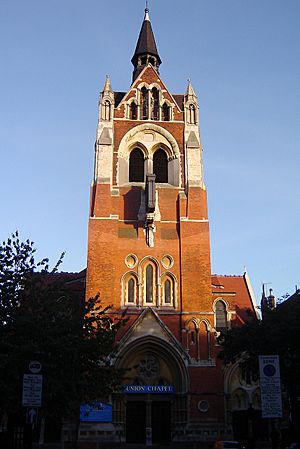Union Chapel, Islington facts for kids
Quick facts for kids Union Chapel |
|
|---|---|

The Union Chapel (October 2006)
|
|
| 51°32′41″N 0°06′09″W / 51.544707°N 0.102503°W | |
| Location | London Borough of Islington |
| Country | England |
| Denomination | Congregationalist |
| Architecture | |
| Architect(s) | James Cubitt |
| Years built | 1874–1877, additions through 1890 |
Union Chapel is a special building in Islington, London, England. It's a church, a place for live music and shows, and a charity that helps people who are homeless.
This amazing building was built a long time ago, in the late 1800s. It has a cool old style called Gothic Revival. Because it's so important, it's a "Grade I-listed" building, which means it's protected. You can find it at the top of Upper Street, close to Highbury Fields.
Contents
A Place for Fun Events
Union Chapel is famous for hosting lots of live events. You can see music concerts, movies, spoken word performances, and comedy shows there. They have about 250 events every year!
People love it because it has amazing sound. This is thanks to how the building was designed. It was even voted London's Best Live Music Venue by Time Out magazine readers in 2002, 2012, and 2014.
Helping People: The Margins Project
The Margins Project is a charity based at Union Chapel. It helps people who are homeless or going through tough times. They offer many services to support them.
For example, they have a drop-in center open twice a week. Here, people can get advice about getting help, take a shower, and do their laundry. The project also helps people who have been homeless find jobs. They even run a warm place to sleep during winter nights and offer support like therapy.
Union Chapel Church Community
Union Chapel is a Congregational church. This means it's part of a group of churches called the Congregational Federation. The church community describes itself as a group of Christians from different backgrounds. They want to live spiritual lives and care about fairness and peace.
The church meets every Sunday morning at 11 am. They are very committed to making things fair for everyone, no matter their race or how much money they have. They also care a lot about protecting our planet.
History of Union Chapel
The first group of people who formed this church met in 1799. They were a mix of different Christian groups. In 1806, they moved into a new chapel built on the same spot where the current building stands. This first chapel was a two-story building with a classic style.
The church also started schools for children. A girls' school opened in 1807, and a boys' school in 1814. A minister named Rev. Thomas Lewis led the chapel for a long time, from 1804 to 1852.
Later, Rev. Henry Allon became the minister in 1852. He helped the church grow a lot as more people moved to the area. The old building became too small for everyone. So, in the 1870s, the chapel was made bigger and given a fancy front with columns.
The building you see today replaced the older one. It was designed by James Cubitt and built between 1874 and 1877. More parts were added until 1890. Its Gothic style is quite unusual for churches like this. It was designed to hold 1,700 people for worship and had a large Sunday School for 1,000 children. Two former Prime Ministers of the UK, William Ewart Gladstone and H. H. Asquith, were once part of this church. The tall tower was finished in 1889.
The chapel building was first recognized as a special, protected building in 1972. It is now a Grade I listed building. The old Sunday school and other parts were also listed as Grade II* in 2011.
In 1981, a charity called Friends of Union was started. This was to stop people from trying to knock down the church. Since then, the Friends have worked hard to keep the buildings safe. Another charity, Union Chapel Project, started in 1991. They organize concerts and events to help raise money for the building and keep it open for everyone to enjoy.
Amazing Organ
The organ at Union Chapel is very special. It was built in 1877 by a famous organ maker named Henry Willis. The architect and the minister at the time wanted the organ to be hidden. They wanted people to focus on the music, not on seeing the organ or the person playing it. So, the organ is hidden behind beautiful screens under a large round window. This window shows eight angels playing different musical instruments, hinting at the organ's importance.
What makes this organ even more unique is its old-fashioned water-powered system. It's one of only two organs left in the UK, and the only one in England, that still has a fully working original hydraulic (water-powered) blowing system. This system can be used instead of electric blowers.
The organ has been carefully repaired and kept in good condition over the years, including work done in 1946 and 2013.
Organ Players
Some talented musicians have played the organ at Union Chapel:
- Henry Gauntlett (1852–1861)
- Ebenezer Prout (1861–1873)
- Fountain Meen (1880–1909)
- John Hooker (1973–2002)
- Claire M Singer (2012–present)
Organ Reframed Festival
Organ Reframed is an exciting music festival that started in 2016. It happens every year at Union Chapel. This festival explores new and experimental ways to use the organ in music. It's put together by Claire M Singer, who is the Music Director for the organ at Union Chapel.
The festival works with groups like London Contemporary Orchestra. They have asked many famous composers and artists to create new music for the organ.
See also
- The Union Chapel Concert – a live music album from 1997 recorded at the chapel.


